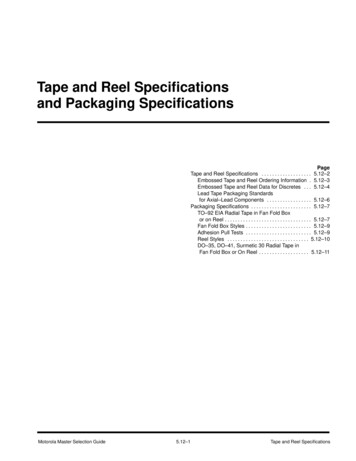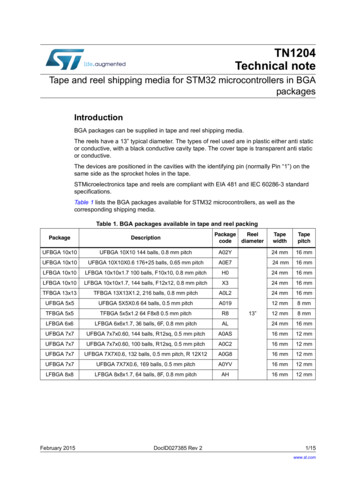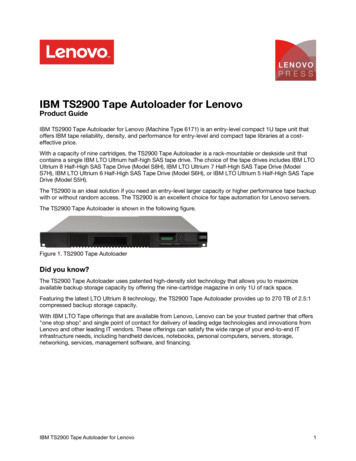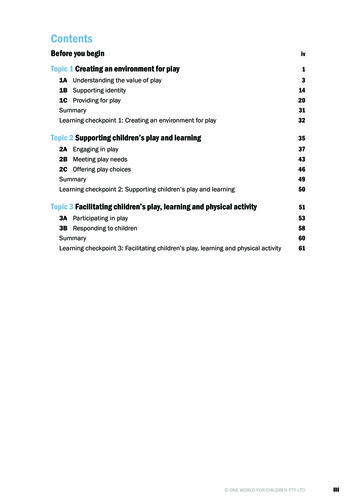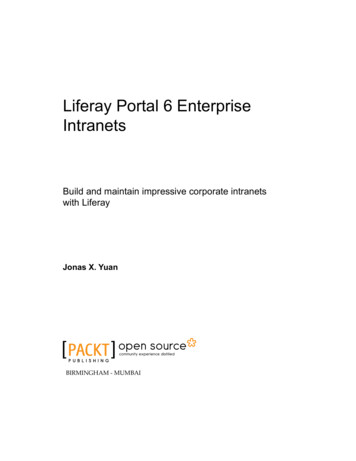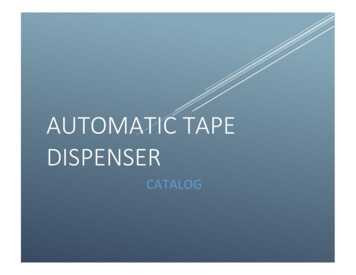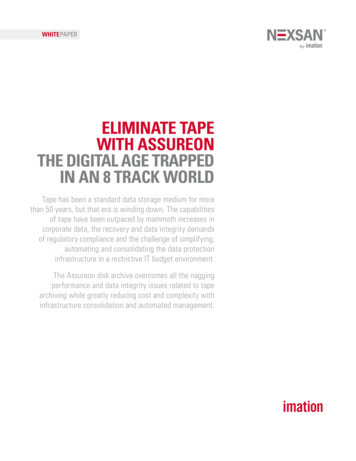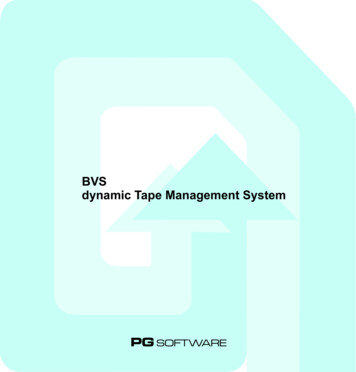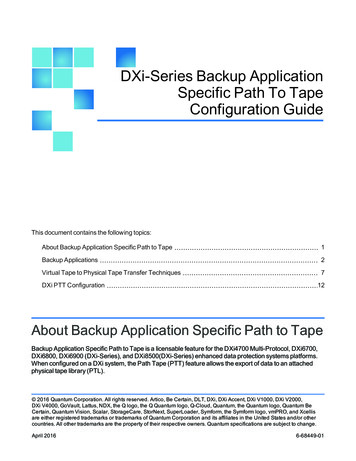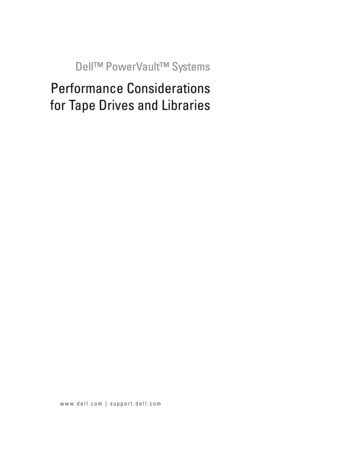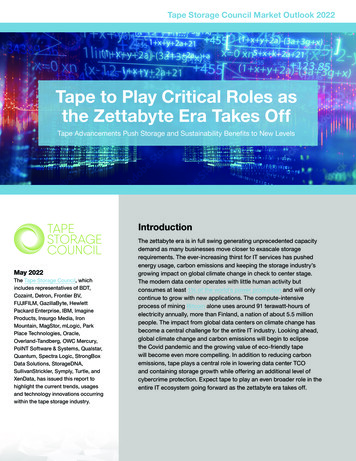
Transcription
Tape Storage Council Market Outlook 2022Tape to Play Critical Roles asthe Zettabyte Era Takes OffTape Advancements Push Storage and Sustainability Benefits to New LevelsIntroductionMay 2022The Tape Storage Council, whichincludes representatives of BDT,Cozaint, Detron, Frontier BV,FUJIFILM, GazillaByte, HewlettPackard Enterprise, IBM, ImagineProducts, Insurgo Media, IronMountain, MagStor, mLogic, ParkPlace Technologies, Oracle,Overland-Tandberg, OWC Mercury,PoINT Software & Systems, Qualstar,Quantum, Spectra Logic, StrongBoxData Solutions, StorageDNA,SullivanStrickler, Symply, Turtle, andXenData, has issued this report tohighlight the current trends, usagesand technology innovations occurringwithin the tape storage industry.The zettabyte era is in full swing generating unprecedented capacitydemand as many businesses move closer to exascale storagerequirements. The ever-increasing thirst for IT services has pushedenergy usage, carbon emissions and keeping the storage industry’sgrowing impact on global climate change in check to center stage.The modern data center operates with little human activity butconsumes at least 1% of the world’s power production and will onlycontinue to grow with new applications. The compute-intensiveprocess of mining Bitcoin alone uses around 91 terawatt-hours ofelectricity annually, more than Finland, a nation of about 5.5 millionpeople. The impact from global data centers on climate change hasbecome a central challenge for the entire IT industry. Looking ahead,global climate change and carbon emissions will begin to eclipsethe Covid pandemic and the growing value of eco-friendly tapewill become even more compelling. In addition to reducing carbonemissions, tape plays a central role in lowering data center TCOand containing storage growth while offering an additional level ofcybercrime protection. Expect tape to play an even broader role in theentire IT ecosystem going forward as the zettabyte era takes off.
Managing the Zettabyte Era Data GrowthData is being generated faster than it can beanalyzed, significantly extending data retentiontimeframes. This amount of data quickly becomescost-prohibitive to maintain online all the time, since60 - 80% of all data stored is infrequently accessedand classified as archival or cold data. As storagerequirements soar, the energy and economic valueof moving cold data from energy-intensive HDDs totape becomes obvious. IDC’s Global Data Storedchart projects 11.1 ZBs of data will be stored in 2025,suggesting between 7.0 - 9.0 ZBs of all data storedin 2025 would be classified as archival or cold, andmost cost-effectively stored on tape. Many largeorganizations are seeing their stored data doubleevery two years. One ZB (zettabyte 1x1018) wouldfill 55.56 million LTO-9 (18 TB) cartridges or 18 TBHDDs, or 125 million years of one-hour TV shows.Source: IDC White Paper, sponsored by Fujifilm, September 2021Accelerating Green Datacenter Progress with Sustainable Storage Strategies, doc #US48252321LTO Tape Supports Zettabyte Era Growth with Record Capacity Shipments in 2021The LTO Program Technology Provider Companies(TPCs), Hewlett Packard Enterprise Company, IBMCorporation and Quantum Corporation, released theirannual tape media shipment report, detailing year-overyear shipments through the fourth quarter of 2021. Thereport reveals 148 Exabytes (EB) of total tape capacity(compressed) shipped in 2021, marking an impressiverecord year for the LTO Program. With a growth rate of40%, this strong performance in shipments continuesfollowing the previous record-breaking 114 EB capacityshipped in 2019 and 105 EB of capacity shipped in thepandemic affected year of 2020. Organizations continueto invest in LTO tape technology thanks to its highcapacity, reliability, low cost, low power consumptionand strong data protection features, especially as threatsto cybersecurity soar.LTO-9 and Higher Performance Features ArriveTape technology highlights include the availability of higher capacity LTO-9 tape drives, access time and data rateimprovements, widespread support for S3 tape as object storage targets, and increased energy efficiency advantagescompared to other storage solutions. The availability of LTO-9 provides a significant boost for cost-effective, scalable, securestorage to address many rapidly evolving 21st century storage-intensive applications. LTO-9 increases the native cartridge22022 Tape Storage Council Report
capacity of LTO-8 by 50% to 18 TB (45 TBcompressed) and increases drive throughput(11%) up to 400 MB/sec enabling a single LTO-9drive to write up to 1.44 TB/hour. A new featurewith LTO-9, oRAO (Open RecommendedAccess Order) reduces initial file access timesto first byte of data. New R/W head and servotechnologies that record even narrower datatracks and further increase cartridge capacityhave also been developed. A native 18 TB LTO9 cartridge can hold about 21 months of datafrom the Hubble Space Telescope, 9,000 hoursof movies or 6,480,000 songs. The currentLTO roadmap has considerable headroomand projects a native cartridge capacity up to144 TBs for LTO-12. The capacity increasesare welcome for enterprise, cloud, HPC andhyperscale data center growth as archival datacontinues to pile up much faster than it is beinganalyzed.Sustainability - Tape Should BeIncluded in Every Green DataCenter StrategyAs the world faces a growing climate crisis,many data centers have established aggressivesustainability goals to reduce energy consumptionand CO2 emissions. Servers and HDDs are the twolargest consumers of data center energy. In majordata centers, energy consumption increased by 31%from 2017 to 2020, and the amount of data stored isexpected to grow by 27% each year through 2025.IDC estimates that globally, migrating more archivaland cold data from HDDs to tape can reduce CO2emissions by 43.7%, or 664 million tons, by 2030.TCO, Energy and Carbon Emissions Reduced With TapeCarbon Emissions Reduction – A research paper issued by Brad John’s Consulting focused on the entire product lifecycle,entitled, “Improving Information Technology Sutainability with Modern Tape Storage.” This report compared an all data on HDDsolution to an all tape solution and an active archive that moved 60% of the HDD resident data to tape. Carbon emissions werereduced by 57% and electronic waste was reducedby 48%. In addition, if all the data was archival/cold and is transferred to tape, carbon emissionsare reduced by 95% and TCO lowered by 73%.Tape offers considerable sustainability and costadvantages while addressing the growing impactthat data centers are adding to climate change.LTO.org offers an easy-to-use TCO calculator toprovide a customized data storage cost profile.Source: Brad Johns Consulting, LLC, July 2021 “Improving Information Technology Sustainability with Modern Tape Storage”2022 Tape Storage Council Report3
Tape Hardens Ransomware and Cybercrime DefenseRansomware has become a nightmare for everyone and no computer system is immune from cybercrime. There is a newattack somewhere on the Web every 39 seconds, or approximately 2,244 daily attacks on the internet. In 2020, the averagedata breach cost was 3.86 million; however, the highest ever ransomware demand grew to 70 million.Quest Strategic Systems reports the average downtime due to a ransomware attack is 21 days. The number of data breachesthrough September 30, 2021, has exceeded the total number of events in full-year 2020 by 17 percent (1,291 breaches in 2021compared to 1,108 breaches in 2020). Ransomware is projected to cost organizations globally up to 20 billion by year-end2021 and to exceed 265 billion by 2031.Tape’s inherent air gap provides additional levels of cybercrime defense. The “tape air gap” means there is no electronicconnection to the data stored on the removeable tape cartridge therefore preventing a direct malware attack (hacking) ontape data. HDD and SSD systems connected and online 7x24x365 are always vulnerable to a cybercrime attack making tapethe only viable data center air-gapped storage solution available. Backup was the original data protection strategy, but havingone backup copy is no longer sufficient. The popular and genetically diverse 3-2-1-1 Data Protection Strategy states thatenterprises should have three copies of backup data on two different media types, one copy offsite and one air gap copy.Combining the air gap copy with encryption and WORM, tape plays an integral role to build and strengthen any data centercyber resiliency strategy.Performance features such as oRAO and TAOScan improve cyber resilience response timesby shortening the time needed to access andrecover backup and archive data from tape.Modern tape provides immutable air gapping atscale at a favorable price point for backup andarchive data and should be an integral part of anydata protection strategy whetheron-premises, in the cloud, or hybrid.The 3 – 2 – 1 – 1 Data Protection Strategy3211Copies of DataDifferent Typesof MediaCopy OffsiteAir GapCopyPrimary copyBackup copy2nd Backup copy(SSD, HDD, Tape)Cloud, remote vault(SSD, HDD, Tape)(Tape)Several tape library vendors are taking air gap protection to the next level by offering libraries with managed partitionsconsisting of dedicated slots which are invisible to external applications. These isolated partitions contain no drives creatinga secure storage location within the library providing an additional barrier to access. They are solely configured by the tapelibrary administrator who may create, modify, delete, or reconfigure partitions to meet any size required.Since partitioned tapes remain in the library, media handling is avoided. Partitions can only be accessed by the libraryadministrator and are not accidentally accessible to any applications.Beyond the LTO RoadmapThe tape industry continues to push data rate, reliability, and media life to record levels surpassing disk drives. In Dec. 2020,IBM and Fujifilm demonstrated a record areal density of 317 gb/in2 on linear magnetic tape which would yield a native cartridgecapacity of 580 TBs using a new magnetic particle called Strontium Ferrite (SrFe). SrFe has improved magnetic characteristicsbeyond Barium Ferrite (BaFe) and delivers even better signal strength. Like BaFe, SrFe is a chemically stable oxide, indicating itwill perform well for long-term data preservation. Laboratory demonstrations suggest relatively few tape technology limitationsfor the coming decade or more, and may signal the way for a new, very low-cost, deep archive storage tier by 2025.Will A New Storage Tier Emerge?Most of the world’s digital data is stored on SSD, HDD, and tape media.As we approach 2025, momentum is building for the emergence of anew deep archive (very cold) secondary storage tier. Deep archivesmust be easily scalable and require minimal remastering (long medialife cycles) and may be the home for the “golden copy”, an immutablemaster copy of the most critical data. Remastering is a labor-intensiveprocess that typically migrates data to new media every 5 - 10 yearsdepending on the technology. Access times of hours or even a few dayscan be acceptable. The optimal design will have a robust roadmap,42022 Tape Storage Council Report
minimal environmental/carbon footprint, and a price point below all other competitive offerings. Deep archives will differ fromtraditional archival data as it will theoretically contain data that is classified as WORSE (Write-Once-Read- Seldom-if-Ever) orWORN (Write-Once-Read-Never).The modern tape roadmap has relatively few areal density limitations and is currently the best positioned technology toaddress a new storage tier. Other technologies are focusing on the deep archive tier and remain under various stages ofdevelopment including DNA which requires the process of encoding and decoding binary data to and from synthesized strandsof DNA. Though the cost of synthesis, access times and reliability compared to magnetic storage present risks and remainunknown.Broader Roles Arrive for Tape - Addressing The LoomingStorage Optimization ChallengeEffectively addressing the storage optimization challenge of “getting the right data, in the right place, at the right time and atthe right cost” presents the biggest returns for storage managers. To meet this challenge, the strengths of tiered storage withSSDs, HDDs, tape, and cloud must be leveraged. As most data ages, access frequency drops off rapidly and data typicallyreaches archival status in 90 - 120 days eventually becoming cold data. However much archival data continues to live on HDDslong after it reaches archival status, an expensive residence for cold data. Fortunately, modern tape technology has improvedaccess times, data rates, and reduced TCO and energy consumption making it best suited to address the growing amount ofcold data. Intelligent data management software and an active archive are key ingredients enabling an optimized and scalablestorage infrastructure to become a reality.The Active Archive - Getting the Right Data, In the Right Place,At the Right Time, At the Right CostStorage optimization receives a big boost from an active archive which provides dynamic optimization and fast data access forarchival storage systems. An active archive integrates two or more storage technologies (SSD, HDD, tape, and cloud storage)behind a file system providing a seamless means to manage archive data in a single virtualized storage pool. SSDs or HDDsserve as a cache buffer for archival data stored on tape providing faster access to first byte of data, higher IOPs, and randomaccess for more active archives. Many data management products now support tape as an object storage target using S3services. Combining the open tape file system LTFS with tape partitioning, data mover software (HSM, etc.), and an SSD, HDDarray or NAS in front of a tape library creates an active archive. LTFS currently has 36 implementers and it is expected thatan increasing number of ISVs (Independent Software Vendors) will exploit LTFS in the future. The active archive concept issupported by the Active Archive Alliance. See the Active Archive conceptual view in the image below.The Active ArchiveIntegrates Intelligent Software and Scalable Storage for the Optimal Archive SolutionPrimary StorageHDD/SSDData CreationUsers & ApplicationsCloud(s) Private,Public HybridGeo RedundancyActive ArchiveCache BufferHDD/SDD or NASIntelligent DataManagement SoftwareOn PremiseTape Library, Air GapBlock, File, ObjectAir Gap Fast Online Accessto Active ArchivalTape Data Metadata Tagging Faster Workflows(LTFS)The Active Archive Combines Software, SSD, HDD, NAS Nodes, Tape and Cloud2022 Tape Storage Council ReportDisaster RecoveryRemote Libraries,Offsite TapeAdditional Copies of Data5
Data-Intensive Applications andWorkflows Fuel New Tape GrowthThe number of vertical markets and more complex use cases effectively addressed by tape continued to expand in 2021as access time improvements, TCO benefits and significantly less environmental impact combined to deliver a highlyeffective and secure storage infrastructure. Tape use cases have been shifting from smaller files to larger, linear datastreams that require intelligent data management services throughout the data lifecycle. The use cases listed below arethriving in the zettabyte era generating enormous amounts of high-value and unstructured data, much of which is storedas archives awaiting future reference. Given that workflow pattern, many of these applications can immediately benefitfrom an active archive implementation leveraging high capacity, low cost tape systems.Big Data6The global big data market size is projected to reach as much as 116billion by the end of 2027. The increasing integration of AI and machinelearning analytics will emerge to accelerate market growth. The marketwas worth 41.33 billion in 2019 and is projected to exhibit a CAGR of14.0% during the forecast period, 2020-2027. Big Data analytics activatecold archives and can realize significant benefits from an active archive.Cloud Storage ServicesThe cloud storage market size was valued at 46.12 billion in 2019, and isprojected to reach 222.25 billion by 2027, growing at a CAGR of 21.9%from 2020 to 2027. Growth is expected to rise from a significant shift tohybrid clouds and data lakes as the primary deployment model. Increasingcloud adoption across industry verticals, security concerns over cloudstorage, high egress fees, and cloud adoption rates among small andmedium enterprises are all significant factors that impact growth of theglobal cloud storage market. It’s estimated that 82% of enterprisestoday use hybrid (on premises and public) clouds.HPCHigh Performance Computing often uses active archives to feedcompute-intensive applications for analytics, pattern recognition, andsimulations to predict outcomes. Despite the turmoil and impact resultingfrom the pandemic, the broad HPC market finished 2020 at 38.9 billionin revenue, down just 0.2 percent from 2019. HPC is returning to growthand is projected to reach 60 billion in 2025.2022 Tape Storage Council Report
The IoTThe total number of IoT connected devices is expected to reach 10.07billion by the year 2021 and reach 25.44 billion by year end 2030. Spendingneared the 761 billion mark in 2020 and is now viewed as a main driverof the digital transformation. The IoT, mobile apps, autonomous vehicles,video, LIDAR, RADAR, drones and sensors will generate data much fasterthan it can be analyzed leaving an enormous archive data pile up ideallystored on tape for future analysis. The IoT market expected to reach 1.3trillion creating countless new storage and data security requirements.Health Care andLife SciencesThe life science analytics market size was valued at 7.7 billion in 2020and forecast to reach 14.1 billion by 2028, a 7.8% CAGR. Increasinguse of big data analytics and predictive analysis to identify future trendsand outcomes are keys for growth. Medical records, images (X-ray, MRI,CT), genome sequences, pharmaceutical development and approval,telemedicine and Covid vaccine research are driving new use cases. LTOwith LTFS allows clinicians and administrators to quickly retrieve and shareEMR, PACS, DICOM and medical data that often resides in data lakes foryears before reference.Media & EntertainmentThe media and entertainment industry, a major tape market, was impactedthroughout 2020 with many live events canceled because of the Covid-19pandemic. For movie production, it is common to have workflows that relyheavily on secure tape to protect and permanently archive raw productionfootage. The global media and entertainment storage market size wasvalued at 6.6 billion in 2019, and is projected to reach 17.9 billion by2027, a CAGR of 13.7%. More than 174 exabytes of storage capacity isprojected for M&E digital archiving, content conversion and preservationby 2024.Physical Security &SurveillanceSports Archivesand Analytics2022 Tape Storage Council ReportVideo surveillance is now the largest video market, and it has becomeevident everywhere. The proliferation of cameras and surveillancesystems across all verticals promises significant and sustainable growthfor the video surveillance storage market. More camera counts, higherresolutions, AI, and metadata-based analytics are straining securityinfrastructures, driving needs for more scale, more performance, andthe latest storage technologies. Raw camera footage typically becomesarchival after 7 days and surveillance retention periods are quicklyincreasing. The global daily average surveillance data generated, beforecutting and editing, is estimated to reach 3.5 exabytes in 2023. Thevideo surveillance market is projected to grow from 7.5 billion in2020 to 10.2 billion by 2025, a CAGR of 6.1%.The MLB Network alone archives over 1.2 million hours of video content,which is indexed and stored with infinite retention periods and makes itavailable to the production team via proxy video. A four-hour MLB gametypically consumes between 1.43 GB and 5.45 GB depending on resolution.In addition to storing and subsequently archiving most sporting eventbroadcasts forever, the global sports analytics market size is expected togrow from 1.9 billion in 2019 to 5.2 billion by 2024, at a CAGR of 22.0%.Major growth drivers of the sports market come from professional andcollegiate teams which are increasing investments for data-driven decisionswith the goal of improving player and team performance.7
Tape Performance ImprovesAccess Times and ThroughputHDDs and SSDs have faster access times to the first byte of data. For large files, tape systems have faster access times to thelast byte of data. A new feature available with LTO-9, oRAO (Open Recommended Access Order) reduces initial file accesstime serving as a data retrieval accelerator enabling applications to retrieve non-consecutive files from tape by optimizingphysical seek times between files. oRAO can reduce initial LTO-9 file access times over 70% while significantly reducingphysical tape movement and drive wear by creating an optimally ordered list of files on a cartridge. LTO-9 increases drive datarate to 400 MB/sec. making it ideal for data streaming and large file transfers.Tape Performance Improvement SummaryAccess Time Improvements (Time to 1st Byte)8Active ArchiveActive Archive greatly improves access time to file and object tape data by usinghigh-capacity HDDs or SSDs as a cache buffer in conjunction with a tape library.oRAOoRAO (Open Recommended Access Order) is new with LTO-9 and produces an optimizedlist called “best access order” enabling applications to retrieve non-consecutive files fromtape by minimizing physical seek times between files.TAOSTAOS (Time-based Access Ordering System) the order in which the LTO files areretrieved can be reordered for “best access” using shortcuts on the tape reducing thetape movement time required to retrieve a file.LTFSLTFS provides access to files directly without the application that wrote the data.Faster LibraryRoboticsFaster, intelligent robotics optimize robotic movements reducing cartridge mount andaccess times while improving reliability.Fastest Data RatesThe LTO-9 and TS1160 enterprise drives each have a data transfer rate of 400 MB/sec.This compares to the 7,200 RPM HDDs ranging between 160 – 260 MB/sec.RAITRAIT (Redundant Arrays of Independent Tape) stripes data across multiple tape drives inparallel significantly increasing throughput and provides parity for data reconstruction likeRAID does for HDDs.RAILRAIL (Redundant Arrays of Independent Libraries) stripes data across tape cartridgesbut in different libraries which may be in different geographic locations.2022 Tape Storage Council Report
The Tape Value PropositionThe current state of the tape industry is highlighted with continued development and investment in smart libraries, new drives,advanced media, and intelligent data management software. The tape value proposition below is compelling and addressesthe relentless demand for higher reliability, higher capacity, better power efficiency, ease of use and the lowest /TB and TCOof any available storage.Tape Performance Improvement n StandardsCurrent State of the Tape IndustryTape has the lowest acquisition price /TB, lowest TCO and lowest carbon footprint.Much Improved – Active archives, fastest data rates, RAIT, smarter and faster robotics, time to1st Byte features (oRAO, TAOS) can reduce tape access times as much as 70%.LTO-9 cartridge capacity @ 18TB (45TB compressed) with 400MB/sec data rate. Exabytecapacity libraries are available. Lab demos demonstrate tape capacities can reach 580TBs.LTO tape drives and LTFS provide open standard interface and access.ScalabilityTape scales capacity by adding media .while adding energy consumption. HDDs add capacityby adding drives with adding energy consumption.Energy/CO2Tape uses much less energy and has much lower carbon footprint than HDDs ( 85%). Playingkey role for attaining corporate sustainability goals.PortabilityTape media easily portable, HDDs difficult to move, in case of data center outages.Data IntegrityTape uses a read-while-writing process that checks data as it is written on tape. HDDsprovide full verify essentially resulting in a 50% data rate reduction.CybersecurityTape air gap, encryption, and WORM provide defense against cybercrime and malware.Durability andReliabilityLTO reliability (BER 1X1019) has surpassed HDDs (1X1016), media life 30 years for modern tape.Recording LimitsCloud StorageHDDs face areal density and performance limits. Defined and sustainable roadmap for tape.Tape improves cloud reliability and security, lowers storage costs and unlimited capacity scaling.Supporting ResourcesAccelerating Green DatacenterProgress with SustainableStorage StrategiesImproving InformationTechnology Sustainabilitywith Modern Tape Storage2022 Tape Storage Council ReportReducing Data CenterEnergy Consumption andCarbon Emissions withModern Tape StorageHow Tape TechnologyDelivers Value in ModernData-driven Businesses9
Saved by the Data. ActiveArchive Leads the Way in aMid-Pandemic WorldProtecting Your Businessfrom RansomwareHyperscale Storage andEnergy ConsumptionData Storage OutlookUnderstanding theData Life CycleHow to Store an ExabyteIs the IOT, Edge & Fog the NextFrontier for Tape Storage?ConclusionAs the zettabyte era accelerates, it’s anticipated that the issue of carbon emissions and climate changewill become even more critical. Fortunately the tape ecosystem has significantly expanded its roles inrecent years evolving from its original function as a backup target to a key storage optimization solutioncontributing significantly to improving carbon emissions from IT operations. While the sustainabilitybenefits of tape are substantial, the corresponding TCO savings from moving cold data from HDDs to tapeare also quite impressive. Tape has become the leading pure storage solution to defend against cybercrimeby seamlessly integrating air gap, encryption and WORM capabilities. New capacity, performance andthroughput advancements have enabled tape to address many storage-intensive vertical markets thatwere previously anchored in the domain of costly HDDs. With these advancements in place, modern tapetechnology delivers the most reliable, energy-efficient and cost-effective storage solutions available todayand has the greatest potential to address the massive capacity demand of the zettabyte era. Roadmapssignal that this trend of steady tape innovation will continue in 2022 and well into the future.Tape Storage Council Members – current list 2022V1-051822
Quest Strategic Systems reports the average downtime due to a ransomware attack is 21 days. The number of data breaches through September 30, 2021, has exceeded the total number of events in full-year 2020 by 17 percent (1,291 breaches in 2021 compared to 1,108 breaches in 2020).
